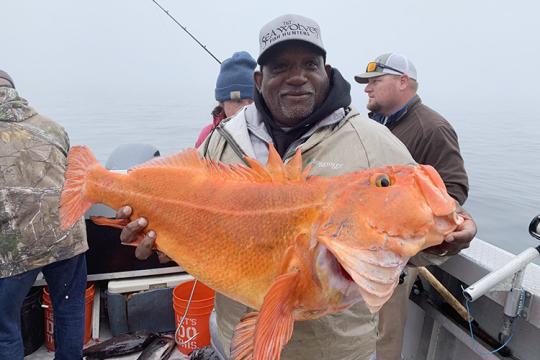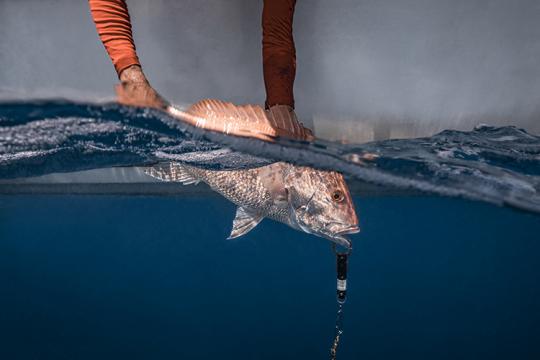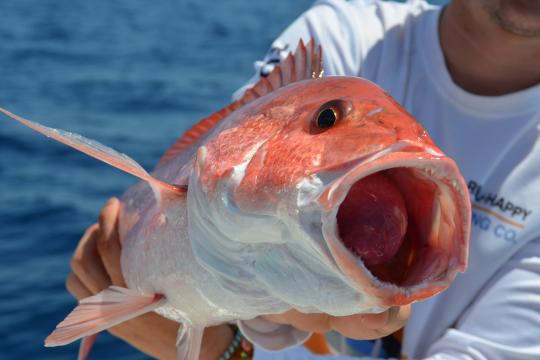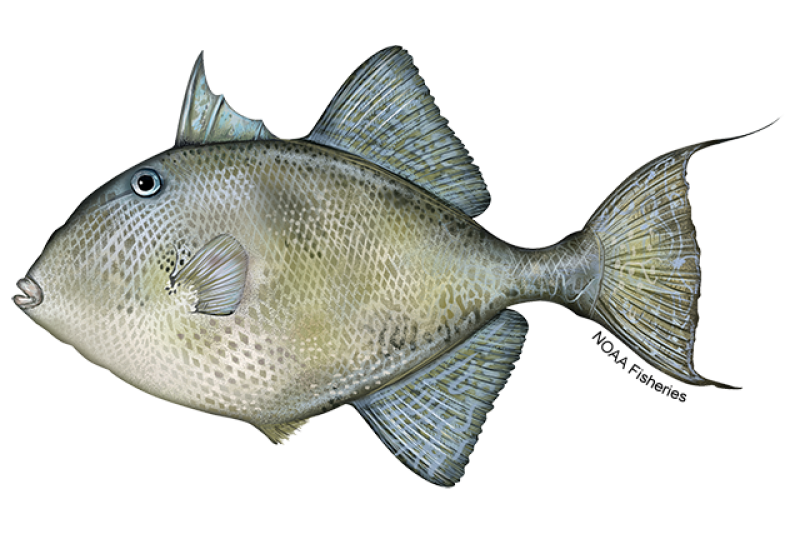 Gray triggerfish. Credit: NOAA Fisheries
Gray triggerfish. Credit: NOAA Fisheries
Gray triggerfish. Credit: NOAA Fisheries
About the Species
 Gray triggerfish. Credit: NOAA Fisheries
Gray triggerfish. Credit: NOAA Fisheries
Gray triggerfish. Credit: NOAA Fisheries
U.S. wild-caught gray triggerfish is a smart seafood choice because it is sustainably managed and responsibly harvested under U.S. regulations.

Population
In the Gulf of America* (formerly Gulf of Mexico), not overfished. In the South Atlantic, the stock has not been assessed, the population level is unknown, and management measures are in place.

Fishing Rate
Not subject to overfishing.

Habitat Impact
Fishing gear used to harvest gray triggerfish has minimal impacts on habitat.

Bycatch
Regulations are in place to minimize bycatch of sea turtles and smalltooth sawfish that may interact with fishing gear used to harvest gray triggerfish.
Population Status
- There are three stocks of gray triggerfish: the Gulf of America stock, the South Atlantic stock, and a stock contained in the Puerto Rico Triggerfishes Complex. According to the most recent stock assessments:
- The Gulf of America stock is not overfished but still rebuilding to target levels (2015 stock assessment), and not subject to overfishing based on 2023 catch data. Summary stock assessment information can be found on Stock SMART.
- Scientists conducted an exploratory assessment of South Atlantic gray triggerfish in 2001 and determined that the stock was not subject to overfishing, but overfished status is unknown. A formal stock assessment has not been conducted.
- The population status of the Puerto Rico Triggerfishes Complex, which includes gray triggerfish, is unknown. The complex has not been assessed, but according to 2022 catch data, the complex is not subject to overfishing.
- Scientists from NOAA’s Southeast Fisheries Science Center monitor the abundance of these populations. Scientists, managers, and stakeholders assess the status of these stocks through the Southeast Data, Assessment, and Review (SEDAR) process.
Appearance
- Adults are primarily olive-gray, have blue spots and lines on the upper body and dorsal (back) fin, and the upper rims of their eyes are blue.
- Adults have the ability to change color, particularly during the spawning season (April to August). Males turn a dark charcoal gray, while nesting females display a contrasting white and black color pattern.
- Juveniles are yellowish with small violet dots and can have large, irregular dark patches on the body and fins.
- Juveniles also have saddle markings and light spots on their dorsal (back) and anal fins.
- Triggerfish get their name from spines on the dorsal (back) fins that can be used as a predator defense and for anchoring. The first spine is large, and when erect it remains so until the fish deflexes the smaller second spine, “triggering” the first. When a triggerfish is threatened it will dive into a tight crevice and anchor itself into place by locking its erect spine.
Biology
- Triggerfish can grow to be up to 13 pounds, 28 inches fork length (length from the tip of the snout to the center of the fork of the tail), and 16 years old.
- Males are larger than females.
- Triggerfish become sexually mature at approximately 2 years old.
- Spawning occurs from April to August. Male gray triggerfish establish territories, build nests in the sand, and entice females into the nest to spawn. The male and female tightly circle one another in the nest, rapidly changing color, and the female deposits eggs in the nest shortly afterward.
- Females deposit an average of 772,415 eggs. After fertilization females aerate the eggs by fanning and blowing on them.
- One male can defend up to three active nests on one reef. An active nest is defined as one female on the nest guarding and aerating the eggs. Females also guard the nest from predators, such as wrasses, groupers, and red snappers.
- Eggs hatch within 24 to 48 hours and the larvae travel to the surface, where they often live among mats of planktonic (open ocean) Sargassum, a floating brown algae.
- Larvae and juveniles spend 4 to 7 months in the planktonic environment before they move to the ocean bottom.
- Adults primarily eat benthic invertebrates including crabs, sea urchins, shrimp, sand dollars, lobsters, and mollusks. They have a small mouth with a strong jaw and specialized teeth used to crush and chisel holes in their hard-shelled prey. Gray triggerfish sometimes direct a stream of water over sandy ocean bottom habitat to expose sand dollars to eat. Juvenile gray triggerfish feed on hydroids, barnacles, and polychaetes.
- Amberjack, grouper, and sharks prey upon adult gray triggerfish; tuna, dolphinfish, marlin, sailfish, and sharks prey upon juvenile gray triggerfish.
Where They Live
Range
- Gray triggerfish are found in the western Atlantic Ocean from Nova Scotia south to Argentina, including Bermuda and the Gulf of America.
Habitat
- Adults live on hard ocean bottoms, reefs, ledges, and artificial reefs at depths of 80 to 300 feet, either alone or in small groups.
- Larvae and juveniles drift up to the surface and develop within the planktonic environment (open ocean), and often live among mats of planktonic Sargassum (a floating brown algae) before they move to the bottom.
Fishery Management
- NOAA Fisheries and the South Atlantic, Gulf, and the Caribbean Fishery Management Councils manage the gray triggerfish fishery.
- In the South Atlantic, managed under the Snapper Grouper Fishery Management Plan:
- Recreational and commercial fishery minimum length limits in federal waters off the east coast of Florida.
- Recreational bag limits.
- Annual catch limits and accountability measures, with automatic triggers to prevent overfishing if the catch limit is exceeded, including shortened future fishing season (recreational) or reduced future catch limits (commercial).
- Requirements to carry NOAA Fisheries approved sea turtle release gear and follow smalltooth sawfish release protocol to reduce bycatch impacts to protected species.
- In the Gulf of America, managed under the Reef Fish of the Gulf of America Fishery Management Plan:
- Recreational and commercial minimum size limits, daily bag limits, and seasonal closures to promote spawning and slow the rate of harvest.
- Annual catch limits with automatic triggers to prevent overfishing if catch limit is exceeded, including shortened future fishing season (recreational) or reduced future catch limits (commercial).
- Requirements to carry NOAA Fisheries approved sea turtle release gear and follow smalltooth sawfish release protocol to reduce bycatch impacts to protected species.
- A rebuilding plan to rebuild the stock to the target population level is in place with a target date of 2026.
- In the U.S. Caribbean, managed under the Puerto Rico Fishery Management Plan:
- Managed together with queen triggerfish and ocean triggerfish in the Triggerfishes complex.
- Recreational and commercial annual catch limits for the Triggerfishes complex.
- Included in the recreational bag limit for select reef fish: 5 fish per person/day, of which no more than 1 may be surgeonfish, or, if 3 or more persons are aboard, 15 fish total per vessel/day, of which no more than 4 may be surgeonfish..
Harvest
- In 2023, commercial landings of gray triggerfish totaled 250,000 pounds and were valued at approximately $900,000, according to the NOAA Fisheries commercial fishing landings database.
- Hand lines and electric or hydraulic reels are primarily used to catch gray triggerfish commercially.
- Recreational harvest is primarily by hook-and-line.
- In 2022, recreational fishermen harvested approximately 1.4 million pounds of gray triggerfish in the Atlantic and the Gulf, according to the NOAA Fisheries recreational fishing landings database.
*Executive Order 14172, “Restoring Names That Honor American Greatness” (Jan. 20, 2025), directs that the Gulf of Mexico be renamed the Gulf of America. On August 7, 2025, NOAA Fisheries and the National Ocean Service amended regulations in the Code of Federal Regulations to reflect the renaming. The name change did not result in any changes to, and had no effect on the applicability or enforceability of, any existing regulations. This website continues to use “Gulf of Mexico” when quoting statutes or previously published materials.
Scientific Classification
- Gray triggerfish are found in the western Atlantic Ocean from Nova Scotia south to Argentina, including Bermuda and the Gulf of America.
- Adults live on hard ocean bottoms, reefs, ledges, and artificial reefs at depths of 80 to 300 feet, either alone or in small groups.
- Larvae and juveniles drift up to the surface and develop within the planktonic environment (open ocean), and often live among mats of planktonic Sargassum (a floating brown algae) before they move to the bottom.
Fishery Management
- NOAA Fisheries and the South Atlantic, Gulf, and the Caribbean Fishery Management Councils manage the gray triggerfish fishery.
- In the South Atlantic, managed under the Snapper Grouper Fishery Management Plan:
- Recreational and commercial fishery minimum length limits in federal waters off the east coast of Florida.
- Recreational bag limits.
- Annual catch limits and accountability measures, with automatic triggers to prevent overfishing if the catch limit is exceeded, including shortened future fishing season (recreational) or reduced future catch limits (commercial).
- Requirements to carry NOAA Fisheries approved sea turtle release gear and follow smalltooth sawfish release protocol to reduce bycatch impacts to protected species.
- In the Gulf of America, managed under the Reef Fish of the Gulf of America Fishery Management Plan:
- Recreational and commercial minimum size limits, daily bag limits, and seasonal closures to promote spawning and slow the rate of harvest.
- Annual catch limits with automatic triggers to prevent overfishing if catch limit is exceeded, including shortened future fishing season (recreational) or reduced future catch limits (commercial).
- Requirements to carry NOAA Fisheries approved sea turtle release gear and follow smalltooth sawfish release protocol to reduce bycatch impacts to protected species.
- A rebuilding plan to rebuild the stock to the target population level is in place with a target date of 2026.
- In the U.S. Caribbean, managed under the Puerto Rico Fishery Management Plan:
- Managed together with queen triggerfish and ocean triggerfish in the Triggerfishes complex.
- Recreational and commercial annual catch limits for the Triggerfishes complex.
- Included in the recreational bag limit for select reef fish: 5 fish per person/day, of which no more than 1 may be surgeonfish, or, if 3 or more persons are aboard, 15 fish total per vessel/day, of which no more than 4 may be surgeonfish..
Harvest
- In 2023, commercial landings of gray triggerfish totaled 250,000 pounds and were valued at approximately $900,000, according to the NOAA Fisheries commercial fishing landings database.
- Hand lines and electric or hydraulic reels are primarily used to catch gray triggerfish commercially.
- Recreational harvest is primarily by hook-and-line.
- In 2022, recreational fishermen harvested approximately 1.4 million pounds of gray triggerfish in the Atlantic and the Gulf, according to the NOAA Fisheries recreational fishing landings database.
*Executive Order 14172, “Restoring Names That Honor American Greatness” (Jan. 20, 2025), directs that the Gulf of Mexico be renamed the Gulf of America. On August 7, 2025, NOAA Fisheries and the National Ocean Service amended regulations in the Code of Federal Regulations to reflect the renaming. The name change did not result in any changes to, and had no effect on the applicability or enforceability of, any existing regulations. This website continues to use “Gulf of Mexico” when quoting statutes or previously published materials.
Scientific Classification
| Kingdom | Animalia | Phylum | Chordata | Class | Actinopterygii | Order | Tetraodontiformes | Family | Balistidae | Genus | Balistes | Species | capriscus |
|---|
Last updated by NOAA Fisheries on 08/20/2025
Featured News
 Fishermen holds up a yelloweye rockfish.
Fishermen holds up a yelloweye rockfish.
 Chef Tyler Hadfield’s Curried Skate Wings with Tomato-Masala Chutney
Chef Tyler Hadfield’s Curried Skate Wings with Tomato-Masala Chutney
Ring In the New Year With These Crowd-Favorite Seafood Recipes
 A red snapper with a SeaQualizer descending device on its mouth. Credit: Return 'Em Right.
A red snapper with a SeaQualizer descending device on its mouth. Credit: Return 'Em Right.
 Barotrauma expands gasses in a fish causing the air bladder and other organs to expand as well, making it difficult for fish to swim after release. Credit: NOAA Fisheries, Florida SeaGrant.
Barotrauma expands gasses in a fish causing the air bladder and other organs to expand as well, making it difficult for fish to swim after release. Credit: NOAA Fisheries, Florida SeaGrant.
Seafood Facts

Is Gray Triggerfish Sustainable?
U.S. wild-caught gray triggerfish is a smart seafood choice because it is sustainably managed and responsibly harvested under U.S. regulations.
Availability
Year-round.
Source
U.S. wild-caught from North Carolina to Texas.
Taste
The meat of gray triggerfish is uniquely sweet. It tastes more like crab than fish. The meat is of excellent quality and is good fresh, smoked, and dried/salted.
Texture
Firm.
Color
The meat is white when cooked.
Nutrition Facts
Servings: 1; Serving Weight: 100 g; Calories: 93; Protein: 21 g; Total Fat: 1 g; Total Saturated Fatty Acids: 0 g; Carbohydrate: 0 g; Total Sugars: 0 g; Total Dietary Fiber: 0 g; Cholesterol: 49 mg; Sodium: 67 mgMore Information
Triggerfish Recipes
Triggerfish is an often overlooked seafood with meat that tastes more like crab than fish. If you need some inspiration to incorporate triggerfish into your rotation, we've got you covered!

Last updated by NOAA Fisheries on 08/20/2025
Seafood News
 Credit: NOAA Fisheries and Partners
Credit: NOAA Fisheries and Partners
Part 2: Seafood Tips from the People Bringing You America's Seafood
 Commercial fishing boats lined up in Sitka, Alaska. Credit: Shutterstock.
Commercial fishing boats lined up in Sitka, Alaska. Credit: Shutterstock.
NOAA Fisheries Seeks Recommendations for Restoring American Seafood Competitiveness

Celebrate Seafood This Holiday Season

Part 1: Seafood Tips from the People Bringing You America's Seafood
Documents
Southeast Otter Trawl and Reef Fish Fisheries Observer Materials
For the Characterization of the U.S. Gulf of Mexico and Southeastern Atlantic Otter Trawl and…
Economics of the Gulf of Mexico Reef Fish Fishery – 2015
ELIZABETH OVERSTREET AND CHRISTOPHER LIESE
Economics of the Gulf of Mexico Reef Fish Fishery – 2016
ELIZABETH OVERSTREET AND CHRISTOPHER LIESE
Data & Maps
Reef Fish Essential Fish Habitat (EFH) Map & GIS Data
Map and GIS data representing EFH for reef fish in the Gulf of America*.
Madison & Swanson Sites & Steamboat Lumps & the Edges Fishery Management Areas Map & GIS Data
Map and GIS data representing Madison and Swanson sites and Steamboat Lumps, and the Edges fishery…
Seasonal Closure of the Recreational Sector for SWG Fishery Management Area Map & GIS Data
Map and GIS data representing the seasonal closure of the recreational sector for shallow-water…
Reef Fish Stressed Area Fishery Management Area Map & GIS Data
Map and GIS data representing the reef fish stressed area fishery management area in the Gulf of…
Outreach & Education
Approved Models and Equipment for Careful Release of Sea Turtles Caught in Gulf of Mexico Reef Fish Fishery and South Atlantic Snapper Grouper Fishery
Information to help fishermen comply with sea turtle release requirements contained in regulations…
Frequent Questions: Landing Federally-Managed Reef Fish Commercially Harvested from Gulf of Mexico Federal Waters
Last Updated: March 2019
Last updated by NOAA Fisheries on 08/20/2025

